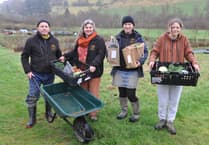A Yew tree in Defynnog churchyard is thought to be the oldest tree in Britain. It is thousands of years old and it its long history will have seen countless generations being baptised, married and buried at the country churchyard.
Situated in the centre of the churchyard, the Defynnnog Yew was declared as the oldest tree in Britain by ancient tree enthusiast, Janis Fry.
Said to be around since the Bronze Age, the Defynnog Yew tree puts the village on the map and even the local pub is named after it, taking the name The Old Yew Tree.
Despite being much older than the Fortingall Yew tree in Perthshire, Scotland, the Defynnog Yew tree is much less well known. Yew trees are evergreen, therefore unlike most trees, their appearance will only change slightly throughout the year. With a girth of around ten metres, the Defynnog Yew tree is nearly as wide as it is tall.
With their strong wood yews were popular choices to make bows for battle in many European countries and it is this use which it is thought accounts for the large number of yews in Wales - which also boasted a reputation for the skills of its bowmen.
With their long drooping branches, yew trees can root into the ground and grow new trunks and in Celtic culture it was believed that Yyew trees symbolised death and resurrection.
This history of the tree is a source of great excitement to Brecon Beacons’ tree hunter Rob McBride, who is no stranger to an ancient tree, goes by the name, ‘The Tree Hunter’.
He recently visited the yew tree in Defynnog and said “It’s a wonderful sight to see, and remarkable to think that it has seen such things like the Romans come and go.”
During his career Rob has made multiple appearances on television programmes, such as the BBC’s Countryfile and ITV Wales’ ‘Wonders of the Border’ with Sean Fletcher discussing ancient trees along the border between Wales and England.
He is extremely passionate about trees, particularly ancient trees, and is involved in many projects to protect trees in order to help the environment.
Rob often attends rallies and spends time talking to politicians to help protect our ancient trees.
Across a thirteen year period, Rob walked Offa’s Dyke and recorded hundreds of ancient trees as he went on his journey, writing a book about the ancient trees that stand along the route of Offa’s Dyke. The book is called ‘The Great Trees of Offa’s Dyke’.
Rob is also a group coordinator for a tree hunting group, and alongside Brecon Beacons National Park Warden, Sam Harpur, he is leading the group in a five year project to record Brecon Beacons National Park’s veteran and ancient trees.
The new network of tree hunters was officilally launched last month by the National Park to record its veteran and ancient trees.
Meeting recently for their first training event at Llanthony Priory, the Brecon Beacons Tree Wardens began the mammoth task of mapping historically important trees across the Park over the next five years.
During the launch day National Park Warden and Group Coordinator, Sam Harpur, and Rob led the wardens on their first veteran tree hunting expedition. The tree wardens are all volunteers and include local woodland and conservation group members and other knowledgeable tree enthusiasts.
Each warden will cover a different area of the National Park, gathering details, statistics and photos of the trees around them and recording data onto a central mapping app.
The long-term aims of the Brecon Beacons tree wardens include information sharing with relevant organisations and networks across Wales and the UK.
There are plans to assist in the management and safeguarding of the notable trees, both for future generations and for the wildlife and biodiversity they support. And as fantastic carbon stores, trees, especially veteran and ancient varieties with their larger capacity to lock up carbon, play a vital part in the fight against climate change which is even more reason to record them.
Sam Harpur, Brecon Beacons Tree Warden Co-ordinator said;“I am incredibly excited to launch the Brecon Beacons tree wardens group and get started on our journey to map the many historically important trees within our designated landscape. None have been fully recorded until now and we look forward to sharing our finds with local communities and young people, encouraging them to celebrate and treasure the Brecon Beacon’s older generation of trees.”
Speaking at the launch of the network Rob added; “Even during the first tree hunt, the group discovered several culturally significant trees including an ancient Cwm-bwchel Pear Tree and a phoenix apple tree. A stunning 300-year-old ash pollard completed a memorable day of immersion in the beautiful countryside and I look forward to finding more of the incredible wonders of the arboreal world in the Brecon Beacons National Park.”
The Brecon Beacons tree wardens and tree mapping project have received funding support from the Authority’s Sustainable Development Fund and the Welsh Government’s Sustainable Landscapes, Sustainable Places Programme.
The churchyard yew tree which changed its sex
Last year The Brecon and Radnor Express reported that another one of Wales’ oldest trees, found in a small village just outside Brecon, had decided to have a late life sex change.
The male yew tree at Llanfeugan Church in Pencelli, believed to be 3,000 years old, shocked villagers by suddenly producing berries.
Yews are typically dioecious, meaning they are one sex or the other.
Male trees have small cones that release clouds of pollen during breeding time with female trees having bright red berries.
Max Coleman, of the Royal Botanic Gardens, noticed Britain’s oldest tree, a Fortingall yew found in Scotland, had changed sex back in 2015.
His discovery made the news all across the globe.
Writing on his blog, Mr Coleman explained: “Odd as it may seem, yews, and many other conifers that have separate sexes, have been observed to switch sex.
“Normally, this switch occurs on part of the crown, rather than the entire tree changing sex.
“In the Fortingall yew, it seems that one small branch in the outer part of the crown has switched and now behaves as female.”
Llanfeugan Church is home to 12 yew trees, of which two are classified as ancient and seven as veteran.
Some believe the trees in the church yard were planted by Pagan Druids and pre-date Christianity.




